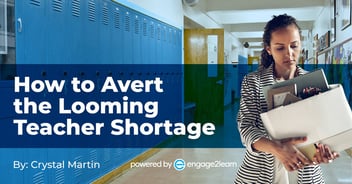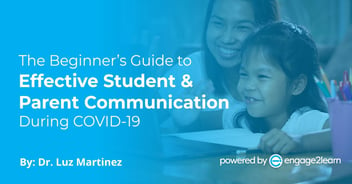How to Increase Engagement in the Virtual Classroom | engage2learn
Over the last three weeks, I have met with 14 Instructional Coaches and 73 teachers on 12 different campuses in two different school districts, and the question that is on everyone’s mind seems to be, “How do I get my students to engage in learning?” Either a.) they aren’t showing up, or b.) they aren’t participating when they do. Now, more than ever, teachers are forced to hand over the learning to their students, and it’s an uncomfortable feeling for most.
The Evolution of Education
When I was an elementary school student in the 1980s my classroom consisted of desks situated in rows, the teacher directing instruction at the front of the room to mostly compliant, but highly disengaged students.
I have a vivid memory of asking the student sitting closest to me for help on a question that I didn’t understand and having to put my nose on the wall for the remainder of class because I was talking. That first grade teacher wasn’t mean, but “talking” in class was definitely not an acceptable behavior. When we completed an assignment, we were expected to wait quietly while everyone else finished, and as I look back on my classroom experiences, I wonder how much instructional time was lost each day.
Through the years, the needs of students have changed, and education has had no choice but to evolve, too. Students required more engaging and collaborative learning experiences and educators shuffled to create those opportunities for them. Over the last 5-10 years, many educators have become much more comfortable with providing a more student-centered learning experience within the walls of their classroom.
But when we were hit with a pandemic and were forced into a world of virtual learning, most of us, quite honestly, weren’t ready at all. Although we have made huge strides, we lack the resources and systems to support our students as they are learning from home.
No one could have predicted what this year would bring, and although the future looks equally uncertain, we can count on one thing: things will never look the same. And yet, global pandemic or not, we have to ensure that students are engaged and learning every day.
So, how DO we increase engagement in the virtual classroom?
Create Personal Connections
Distance learning can feel impersonal. Recreating an in-person learning environment is hard for many reasons. Missing out on human connection is one of them, but we don’t have to sacrifice our relationship with students or their relationship with each other while in a virtual classroom. Here are some quick, actionable steps that can help foster personal connections in the virtual classroom:
- Greet students by name as they enter the virtual classroom. You might not physically be able to give them a handshake, a high five, or a fist bump, but greeting students by their name show that you notice them and are glad they are here.
- Schedule virtual small group meetings where students can connect with each other and with the facilitator on a deeper level. Many students feel anxious about turning their camera on or unmuting in front of the whole group, but they may feel more comfortable with a smaller group.
- Give students a choice about how they would like to communicate. Request feedback to find out if they’d rather use the chat or share out verbally.
- Reach out to families regularly and use warm feedback to start the conversation. This creates a safe space before sharing concerns with family members.
- Build in a few minutes at the beginning of a virtual session to share celebrations. Call on students randomly, or let them know ahead of time that it’s their turn to share.
- Let students help facilitate virtual meetings by utilizing team roles. Virtual team roles might include roles like co-facilitator, chat monitor, timekeeper, and workshop manager.
- Begin synchronous meetings with a “hook” like a song or video that might capture learners’ attention and that students can make connections with.
- Discover tools that your current Learning Management System offers that support communication and collaboration. Our team at e2L created Virtual Professional Learning Courses to support districts in utilizing different Learning Management Systems. These courses highlight ways to engage students and communicate with students and families.
Recognize Desired Behaviors with Incentives
Implementing incentive systems creates a culture of positivity, reinforces expectations, and increases engagement. In Atomic Habits, James Clear states:
“Rewards are the end goal of every habit. The cue is about noticing the reward. The craving is about wanting the reward. The response is about obtaining the reward. We chase rewards because they serve two purposes: (1) they satisfy us and (2) they teach us.”
If our highest hopes are that students will develop healthy academic and social habits then it’s important to celebrate when they achieve their goals. Offering incentives to celebrate growth is less about the incentives themselves and more about the systems that are put in place. Virtual incentive systems like Class Dojo help to promote positive behaviors by rewarding students with points and giving immediate feedback.
Creating opportunities for students to earn incentives might look a little different in a virtual environment, but there are some great ideas available. Get students involved by asking how they would like to be rewarded. Check out these virtual incentive ideas that students have come up with:
- Virtual Lunch Buddies: allow students to select a buddy to eat lunch with and arrange a virtual meeting with those students.
- Lunch and a Movie: invite students who have achieved their goals to join in for a virtual class lunch and movie date.
- Show and Tell: with students being at home, it’s easy for them to share personal things that they wouldn’t normally be able to bring to school.
- Free Homework Pass: as students meet goals, they could choose an assignment from which to be excused.
- Virtual Games: there are a plethora of school-appropriate online games that students could choose from as a reward.
Quality vs. Quantity
Students learning from home often have many obstacles to overcome. Remembering that not all learners have parent support or a place to learn that is free from distractions is vital. Some students are home alone or taking care of siblings during the day, making it difficult to manage academic tasks. When it comes to remote learning, quality outweighs quantity. Giving students too much extra work can lead to burnout for both teachers and students. Ask yourself if the resources, activities, and assessments are:
- Easy to access and user friendly
- Engaging and relevant to student interests
- Appropriately assessing student progress
- Aligned to standards
- Scaffolded to support all learners
- Personalized to meet student needs
If not, it’s okay to abandon what isn’t working and remember that not all learners need the same resources. You can also leverage the rubric builder in eSuite’s Learning Design App, eLX to make sure all aligned and scaffolded for learners at every level of mastery.
Virtual Learning is Now Our Reality
Virtual learning is now our reality, and it’s our responsibility to create a learning environment that is engaging for our students, and that won’t happen if we simply make analog teaching digital. We understand the challenges that districts are faced with every day. We are working every day to support educators in learning how to best use the various tools at their disposal to create and facilitate mastery learning that meets the need of every student regardless of their learning environment. Our hope is to support educators by helping them simplify their processes by thinking outside of the box and making the necessary shifts that lead to success through student engagement.



